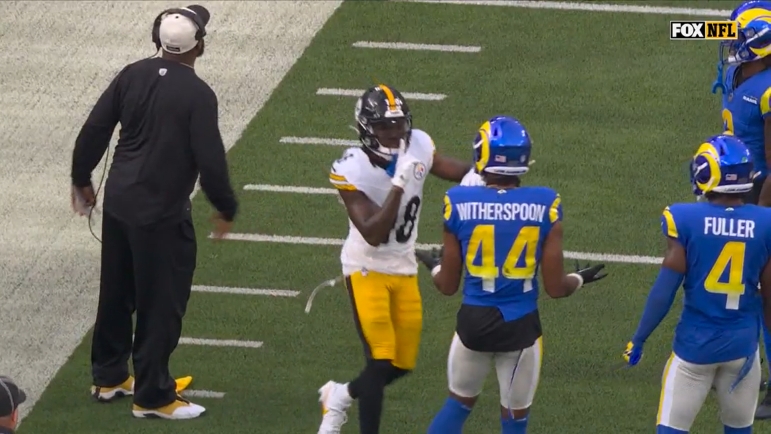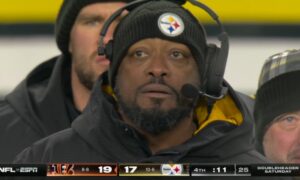Pittsburgh Steelers head coach Mike Tomlin was critical of his group’s lack of discipline and situational awareness on Sunday when it came to allowing emotions to spill out into multiple taunting penalties. He described it as not adjusting to the tenor of the officiating crew and how it would be calling the game.
Nevertheless, he still had questions about how those penalties were enforced—or at least the last one. That one came on 3rd and 8 with about three minutes to go in the fourth quarter. WR Diontae Johnson managed to draw a defensive pass interference penalty on CB Ahkello Witherspoon, and after Witherspoon negatively reacted to the call, the wide receiver walked up to him with his finger over his lips to tell him to be quiet and stop complaining.
That brought the flag out, but to the surprise of many, the result of the call was offsetting penalties. Many expected that the defensive pass interference penalty would result in a spot foul and a new set of downs, after which the taunting penalty would be enforced. Instead, the down was replayed. Tomlin wanted to know why, too.
“I asked that, but in the midst of all the discussions and ongoing things, they never got back to me to explain the reasons why”, he said, via the team’s website, during his weekly press conference. “One guy said it was considered a continual act, but I never had a conversation with a white hat specifically regarding it”.
Many fans are under the impression that live ball fouls and dead ball fouls are always enforced separately (and taunting fouls are always considered dead ball fouls no matter when they occur), but this is not the case according to the NFL Rulebook.
Section 4, Article 9, for example, points out that “Live Ball Fouls and Dead Ball Fouls combine to create Double Fouls or Multiple Fouls, and all customary rules for enforcement apply”. Section 14, Article 1e notes that “A Double Foul is a foul by either team during the same down during which both teams commit at least one foul, including dead ball fouls”.
More specifically, in Section 5, Article one, the rule states that “If there is a Double Foul during a down in which there is not a change of possession, the penalties are offset, and the down is replayed at the previous spot. If it is a scrimmage down, the number of the next down and the line to gain is the same as for the down in which the fouls occurred”.
So the defensive pass interference and taunting penalties formed a double foul, and as a result, offset one another. The penalties were properly enforced, which meant that the Steelers still had to gain another first down in order to close out the game. Fortunately, they did. Especially since the pass interference was a bad call to begin with. And so was the spot on their successful 4th-and-1 conversion, but we don’t need to get into that.








